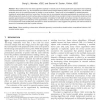Free Online Productivity Tools
i2Speak
i2Symbol
i2OCR
iTex2Img
iWeb2Print
iWeb2Shot
i2Type
iPdf2Split
iPdf2Merge
i2Bopomofo
i2Arabic
i2Style
i2Image
i2PDF
iLatex2Rtf
Sci2ools
132
Voted
PAMI
2010
2010
Differential Geometric Inference in Surface Stereo
—Many traditional two-view stereo algorithms explicitly or implicitly use the frontal parallel plane assumption when exploiting contextual information since, e.g., the smoothness prior biases toward constant disparity (depth) over a neighborhood. This introduces systematic errors to the matching process for slanted or curved surfaces. These errors are nonnegligible for detailed geometric modeling of natural objects such as a human face. We show how to use contextual information geometrically to avoid such errors. A differential geometric study of smooth surfaces allows contextual information to be encoded in Cartan’s moving frame model over local quadratic approximations, providing a framework of geometric consistency for both depth and surface normals; the accuracy of our reconstructions argues for the sufficiency of the approximation. In effect, Cartan’s model provides the additional constraint necessary to move beyond the frontal parallel plane assumption in stereo reconstruct...
Related Content
| Added | 29 Jan 2011 |
| Updated | 29 Jan 2011 |
| Type | Journal |
| Year | 2010 |
| Where | PAMI |
| Authors | Gang Li, Steven W. Zucker |
Comments (0)

